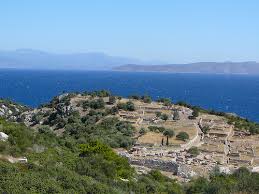
There are so many ancient sites around Athens that we do not know about. One of them is the ancient site of Rhamnous (Greek: Ραμνούς), on the Attica coast about 55 km northeast of Athens. The ruins are found outside the town of Agia Marina in the Municipality of Marathon, the area in which the famous battle of Marathon took place against the Persian in 490 BC.

The site takes its name from the local prickly bush called Rhamnous or Buckthorn, a small bush that produces red berries and is usually found along coastal areas as it withstands the sea breezes. During the Byzantine period it was considered the plant of chastity (Greek: φυτό της άγνειας). It was believed that if a person consumed these berries, it would stop them from having sexual desires. The cleric and monks were advised to eat the small berries of the Rhamnous plant so that they could maintain their physical and mental health. Therefore, this plant was often found in their gardens and they ate it at regular intervals.
The fortified settlement of Rhamnous was of strategic importance to Athens as it overlooked two small harbours and guarded the sea route between Attica and Euboia. The harbours provided shelter for the ships using these routes. Also, grain was imported into Athens through these harbours during the Peloponnesian War (431-404 BC). Athens had a garrison of ephebes (Greek: έφηβοι) stationed there to guard the area in order to keep the sea route open and safe. They were young men between 17 and 18 years old going through a period of initiation that included military training.
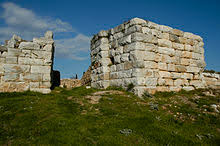 The ancient township of Rhamnous has a heavily fortified outer wall with a gate flanked by two towers as well as a lighter inner wall guarded by a tower at the summit of the hill. Other structures include a small theatre, a gymnasium, a number of public buildings and houses. Burial monuments are found along the ancient road connecting Rhamnous and the neighbouring deme.
The ancient township of Rhamnous has a heavily fortified outer wall with a gate flanked by two towers as well as a lighter inner wall guarded by a tower at the summit of the hill. Other structures include a small theatre, a gymnasium, a number of public buildings and houses. Burial monuments are found along the ancient road connecting Rhamnous and the neighbouring deme.
The settlement contains the main sanctuary of Nemesis, the goddess of divine retribution, an avenging goddess to those that succumbed to hubris (Greek: ύβρις): those that showed arrogance against the gods. She also punished those that did evil deeds or came into undeserved good fortune. Nemesis means to give what is due (Greek: νέμειν – nemein). A hymn written to Nemesis in the early 2nd century AD addresses her as: Nemesis, winged balance of life, dark-faced goddess, daughter of life.
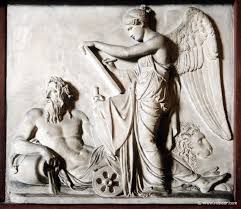 She was believed to be the daughter of the primodial god Oceanus. However, according to Hesiod, a poet and writer of Theogeni, she is the daughter of Erebus and Nyx, goddess of night. She is also said to be the mother of Helen of Troy. Nemesis tried to avoid the advances of Zeus by changing into a goose. However, Zeus turns into a swan and mates with her. Nemesis in her bird form lays an egg in the marshes, which is found by a shepherd. He takes it to Leda, the queen of Sparta and wife of king Tyndareus. Leda puts the egg in a chest and when it hatches, Helen arises from it. Although Helen later becomes the wife of King Menelaus of Sparta, her beauty leads to her kidnapping by prince Paris of Troy and to the Trojan War around the 13th – 12th century BC.
She was believed to be the daughter of the primodial god Oceanus. However, according to Hesiod, a poet and writer of Theogeni, she is the daughter of Erebus and Nyx, goddess of night. She is also said to be the mother of Helen of Troy. Nemesis tried to avoid the advances of Zeus by changing into a goose. However, Zeus turns into a swan and mates with her. Nemesis in her bird form lays an egg in the marshes, which is found by a shepherd. He takes it to Leda, the queen of Sparta and wife of king Tyndareus. Leda puts the egg in a chest and when it hatches, Helen arises from it. Although Helen later becomes the wife of King Menelaus of Sparta, her beauty leads to her kidnapping by prince Paris of Troy and to the Trojan War around the 13th – 12th century BC.
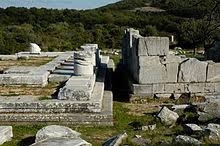
The temple of Nemesis was constructed in the 5th c. BC using the Doric style of architecture. The famous statue of the goddess was the work of Agorakritos, a pupil of the famous sculptor Pheidias. According to Pausanias, a traveller and geographer of 2nd c. AD, the statue was made from a specific piece of marble from the island of Paros, which had been brought there by the Persians to use for the trophy of their victory at the battle of Marathon.
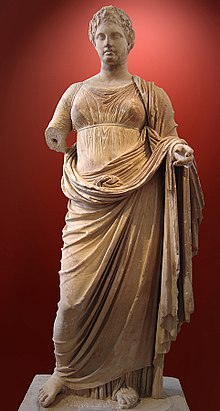
There is also a smaller temple of Themis (Greek: Θέμις), goddess of divine order, fairness, law, natural law and custom. Her symbols are the Scales of Justice. When Themis is not taken into consideration, Nemesis takes over and brings just and wrathful retribution.
Therefore, it is only right that her temple is next to that of Nemesis. Her statue as well as other relics from the settlement are in the National Archaeological Museum of Athens. The base of her statue bears an inscription with the name of the local sculptor Chairestratos.
The worship of Nemesis ended around 382 AD when the Byzantine emperor Arcadius ordered that all pagan temples be destroyed. The whole area slowly declined, but the remains of the sanctuary and the fortifications can still be seen today. The first excavations at the site were carried out in 1813 by the Society of Dilettanti, a society of British noblemen and scholars that was founded in 1734 to sponsor the study of ancient Greek and Roman art. From the 19th century the excavations have been taken over by the Athens Archaeological Society.